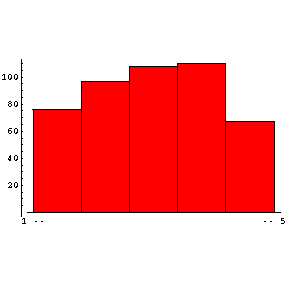April, 2003
PHY110Y/PHY138Y Laboratory Evaluation
Prepared by David Harrison
INTRODUCTION
Ruxandra recently surveyed students in our PHY110Y/PHY138Y Laboratory about
their opinions regarding the lab. This document summarises the results.
458 students participated, which is 41% of the students enrolled in the laboratory.
This participation rate is less than usual; last year the figure was 60%.
In the table below, the numbers in parentheses were the responses to the same
question in last year's evaluation. In general, students this year were less
positive about the lab than last year.
I have two comments about this year's laboratory which may relate to the results
of the evaluation.
- Group sizes were if anything somewhat larger than last year, and were the
largest ever. We believe that the size of the group is a major factor in student
satisfaction and learning.
- The academic staff complement this year was about 1.25 FCE instead of last
year's 2.00.
MULTIPLE CHOICE QUESTIONS
Here is a comparison of the overall rating of the laboratory
this year and in three previous years:
Percentage of Students Whose Overall Rating of the Laboratory Was "Excellent",
"Good", or "Fair"
| Physics Course |
This Year |
Spring 2002 |
Spring 2001 |
Spring 1998 |
| PHY110Y |
(55.3 ± 7.7)% |
(62.3 ± 9.0)% |
(77.7 ± 9.1)% |
55% |
| PHY138Y |
(60.9 ± 4.1)% |
(70.6 ± 3.9)% |
(83.9 ± 4.7)% |
74% |
In the above table, the errors assume that the uncertainty in the number of
responses is the square root of the number.
BEST AND WORST EXPERIMENTS
In addition to the multiple choice questions summarised above, we asked
the students two related questions:
- Which experiment was the best you have done this year?
- What was the worst experiment you have done this year?
A typical student in the laboratory does 5 or 6 experiments in the course of
the year. It is perhaps amazing that virtually every experiment in the laboratory
is cited as best by some students and worst by others. This
occurs every year.
Here are this year's results for these questions. The numbers in parentheses
are from last year.
Core Experiments
| Experiment |
Number Saying it Was the Best |
Number Saying it Was the Worst |
| Free Fall |
66 (97) |
19 (26) |
| Air Track |
25 (17) |
7 (5) |
| Heat Capacity |
18 (19) |
8 (7) |
| Absolute Zero |
8 (20) |
9 (15) |
| DC Circuits I |
31 (63) |
46 (53) |
| Velocity of Sound in a Pure Gas |
2 (18) |
20 (24) |
| Lens Optics |
8 (25) |
29 (35) |
| Boyle's Law |
24 (28) |
20 (41) |
| Spectra |
31 (28) |
46 (47) |
| Thermal Expansion |
43 (19) |
9 (32) |
| Speed of Sound in a Solid |
8 (7) |
24 (28) |
| Vapor Pressure |
6 (4) |
10 (14) |
| Standing Waves |
3 (3) |
19 (30) |
Another recurring surprise is that some experiment's "popularity"
changes dramatically from year to year. Above the Thermal Expansion
experiment shows a large change from last year, although the apparatus and Guide
Sheet are identical.
For the Non-Core experiments, we only include ones that have 5 or more
votes as best or worst.
Non-Core Experiments
| Experiment |
Number Saying it Was the Best |
Number Saying it Was the Worst |
| Electrocardiogram |
18 (7) |
9 (0) |
| Optical Activity |
7 (6) |
3 (1) |
| Surface Tension |
8 (6) |
1 (4) |
| Optical Fibers |
0 (NA) |
7 (NA) |
Speed of Light |
4 (NA) |
5 (NA) |








